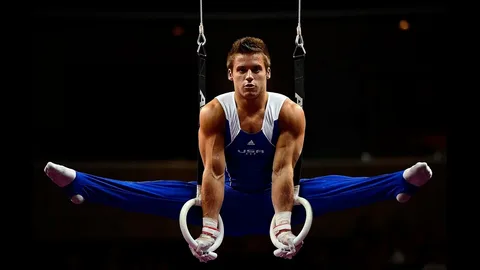Why the Gymnastics Rings in the Olympics Are a Big Deal
Not every Olympic event makes your jaw drop. But the gymnastics rings Olympics event? That’s pure magic and muscle. The problem is, most people don’t realize how difficult and powerful this event truly is. It’s often overshadowed by flashier routines like floor or vault. Yet, the rings demand unmatched upper-body strength, balance, and patience.
Now imagine training for years just to hold your body still perfectly still while hanging from two small circles. That’s the real challenge. And here’s the good news: the gymnastics rings are gaining more spotlight each Olympic season. With this guide, you’ll understand the skill, the training, and the beauty behind one of the toughest events in the Games.
The History and Evolution of Rings in Olympic Gymnastics
The gymnastics rings have been part of the Olympic story since the very beginning. This event was introduced in the 1896 Athens Olympics, making it one of the oldest gymnastic disciplines. Back then, routines were simpler but still focused on control and form.
Today, the event has evolved. Movements are more complex. Judges now look for a perfect mix of still holds, strength, and clean transitions. Rings performances have become more technical, requiring years of fine-tuned muscle memory.
From Simplicity to Spectacle
In the early 1900s, athletes performed basic holds and swings. It was all about elegance and form, not just power. Over time, routines became harder, with signature moves like the Iron Cross and Planche Hold.
Rings Go Global
Countries like Japan, China, and Russia started dominating the sport post-WWII. These nations brought in intense training techniques and began producing champions.
How Rules Have Changed
Judging now focuses on difficulty, execution, and control. Deductions are given for shaking, body movement, or improper holds.
Inside the Rings Routine: What Makes It So Tough?
The gymnastics rings Olympics routine is no walk in the park. Athletes must complete a series of moves while barely swinging. Imagine holding yourself steady with your arms stretched out for 2–3 seconds while hanging in midair. Yep, it’s as hard as it sounds.
The rings routine includes holds, strength elements, and controlled transitions. What’s unique is that the rings aren’t fixed, so they move slightly. That makes balance extremely difficult, even for seasoned athletes.
Key Strength Elements
Some of the most iconic moves include:
-
Iron Cross: Arms stretched horizontally while body stays vertical
-
Maltese: Body held parallel to the ground, chest facing down
-
Planche: A horizontal hold with hands gripping the rings
Timing and Transitions Matter
Routines are timed for about 60 seconds. Each move must flow smoothly into the next. Any shake, pause, or jerk can lead to a deduction.
Scoring and Precision
Points are awarded for difficulty and deducted for errors. Even a slight tremble in a hold can cost the gymnast a medal spot.
Famous Olympic Ring Champions Who Raised the Bar
Every sport has its legends. The rings event is no different. Over the years, a few athletes have set the gold standard for what greatness looks like hanging above the floor.
These champions didn’t just win medals — they redefined what was possible in the sport. Through sweat, discipline, and raw talent, they earned their place in Olympic history.
Yuri van Gelder: The Lord of the Rings
Known for his flawless control and calm, van Gelder stunned the world with his strength holds. He made rings look effortless.
Chen Yibing: The King of Stillness
Chen won multiple Olympic and world titles for China. His Iron Cross was so still, it looked like someone pressed pause.
Eleftherios Petrounias: The Greek Machine
Petrounias combined showmanship with discipline. He turned strength into art and gave Greece a proud Olympic moment.
How Athletes Train for the Gymnastics Rings Olympics
If you thought regular gym workouts were tough, think again. Training for the Olympic rings is a whole new level. It’s not just about lifting weights — it’s about controlling your body like a machine.
These athletes work year-round, building every muscle group, improving grip strength, and rehearsing every second of their routine. It takes years to master.
Daily Strength Training
Olympic ring athletes focus heavily on:
-
Core and shoulder exercises
-
Bodyweight holds
-
Wrist and grip conditioning
They train to resist shaking, stay calm under pressure, and stay stable mid-air.
Mental Focus is Key
Rings don’t just test your body — they challenge your mind. A gymnast must stay completely focused for the entire routine. One slip can ruin it all.
Recovery and Nutrition
To stay at peak performance, athletes follow:
-
Strict diet plans
-
Sleep and rest cycles
-
Regular physio sessions
Without recovery, even the strongest bodies will fail.
Read Also: Farazi Hususta Dazny.Com: Easy Guide to This Cool Digital Website
How You Can Get Started with Rings at Home or the Gym
You don’t have to be an Olympian to start using gymnastics rings. They’re now popular in home gyms and fitness centers. And the best part? They offer full-body workouts using only your weight.
With consistency and patience, you can build serious strength. Plus, rings are fun once you get the hang of them!
Choosing the Right Equipment
When buying rings:
-
Look for wood or heavy-duty plastic
-
Use adjustable straps
-
Make sure you have a safe space for setup
Starting with Basic Moves
Begin with:
-
Ring rows
-
Push-ups
-
Assisted dips
-
Tuck holds
Start slow and listen to your body. These workouts are harder than they look.
Progressing to Advanced Levels
Once you’re strong enough, you can try:
-
False grip training
-
Inverted holds
-
Skin-the-cat and basic levers
Keep practicing and soon you’ll understand what it takes to reach that Olympic level!
Conclusion: The Rings Event Is the Heart of Olympic Strength
The gymnastics rings Olympics event might not have the flips and sparks of other gymnastic performances. But it’s where you truly see what raw strength and control look like. Every second a gymnast holds that Iron Cross, they’re telling a story of hard work, focus, and discipline.
So next time you’re watching the Olympics, don’t blink when the rings event starts. There’s magic happening right above the floor. If you’re inspired, why not try training yourself? You might not be aiming for a gold medal, but you’ll definitely feel stronger, more focused, and more connected to the amazing athletes you just read about.



